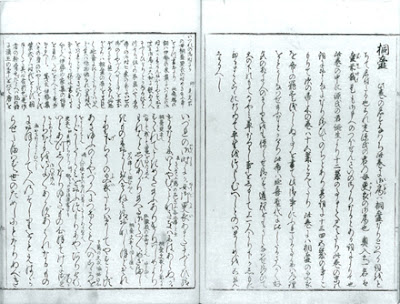:::::::::::::::::::::::::::::::::::::::::::::::::::::::::::::::::::::::::::::::::::::::::::::::::::
Kitamura Kigin Day
***** Location: Japan
***** Season: Late Summer
***** Category: Observance
*****************************
Explanation

Kitamura Kigin 北村季吟
1625-1705. June 15, 6月15日
1625年1月19日(寛永元年12月11日) - 1705年8月4日(宝永2年6月15日)
Dates vary according to the Asian Lunar Calendar.
Day of Kigin, Kigin Ki 季吟忌 (きぎんき)
Day of Shuusui Ken,
Shuusui Ken Ki 拾穂軒忌(しゅうすいけんき)
He was the haiku teacher of Matsuo Basho, Yamaoka Genrin 山岡元隣 and Yamaguchi Sodoo 山口素堂.
He was a famous writer and compiler of the early Edo period. He also used these pen names:
静厚、通称は久助、別号は慮庵・呂庵・七松子・拾穂軒, Kogestu Tei 湖月亭
He belonged to the Teimon Group of haiku, Teimon Ha 貞門派 of Matsunaga Teitoku.
He was born in present-day Shiga prefecture, former Omi province.
He was the haiku student of Yasuhara Teishitsu 安原貞室 and Matsunaga Teitoku 松永貞徳.
He edited some old pieces of literature, for example the Tale of Genji, the Tosa Nikki (Tosa Diary) and the Tales of Ise.
He compiled an important collection of seasonal words and topics:
北村季吟『山之井』 Yama no I
by Kitamura Kigin [1624 -1705]comp. 1647-8
It contained 1300 kigo.
............... later republished as
Zoo yama no i "Expanded Mountain Well "Yama no I" 1667
. WKD : History of Japanese Saijiki .
:::::::::::::::::::::::::::::::::::::::::::::::::::::::::::::::::::::::::::::::::::::::::::::::::::::

He rewrote more than 180 classic novels into easier language, some of which are the The Tales of the Genji, Makurano Soushi, The Tales of Yamato, The Diary of Tosa, and The Tales of Ise. The Yedo government presented him with a title Houin and invited him to Yedo.
In his later life he devoted himself to educating his students, many of whom became influential, among them the famous Matsuo Basho.
Kitamura Kigin died at 82.
© Photo and Text : kinki/yasu

:::::::::::::::::::::::::::::::::::::::::::::::::::::::::::::::::::::::::::::::::::::::::::::::::::::
The Invention of a Literary Tradition of Male Love
Kitamura Kigin's "Iwatsutsuji 岩つつじ"
Paul Gordon Schalow
Ominaeshi monogatari, (1661; Tales of Lady Flowers)
a collection of anecdotes and legends about female poets.

湖月抄 Kogetsushoo
*****************************
Worldwide use
*****************************
Things found on the way
Reference : 北村季吟

地主神社 Jishu Shrine Visit, Kyoto
*****************************
HAIKU
*****************************
Related words
***** Memorial Days of Famous People / SAIJIKI
History of Japanese Saijiki
Matsunaga Teitoku 松永貞徳 (1571-1653)
Introducing Japanese Haiku Poets
::::::::::::::::::::::::::::::::::::::::::::::::::::::::::::::::::::::::::::::::::::::::::::::::::






1 comment:
鬼百合や蛍火とぼす灯台鬼
oniyuri ya hotarubi tobosu toodaiki
tiger lily -
a candlestick demon glows
like a firefly
.
- On a summer evening, the tiger lilies in the late sunshine glow almost like candlestick demons.
.
What is a candlestick demon?
https://kappapedia.blogspot.jp/2017/12/todaiki-candlestick-oni.html
.
Post a Comment